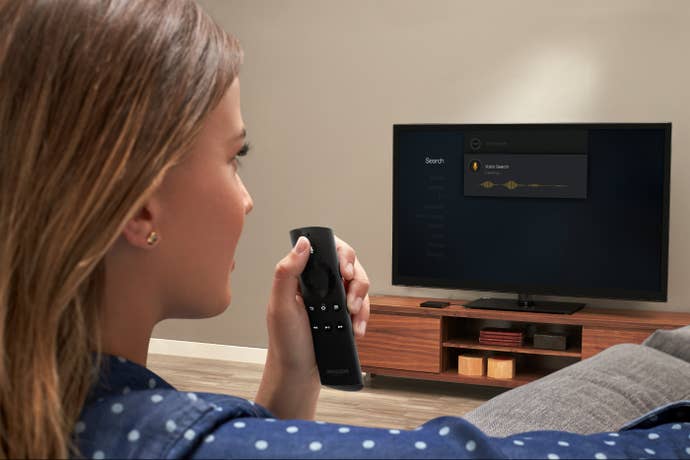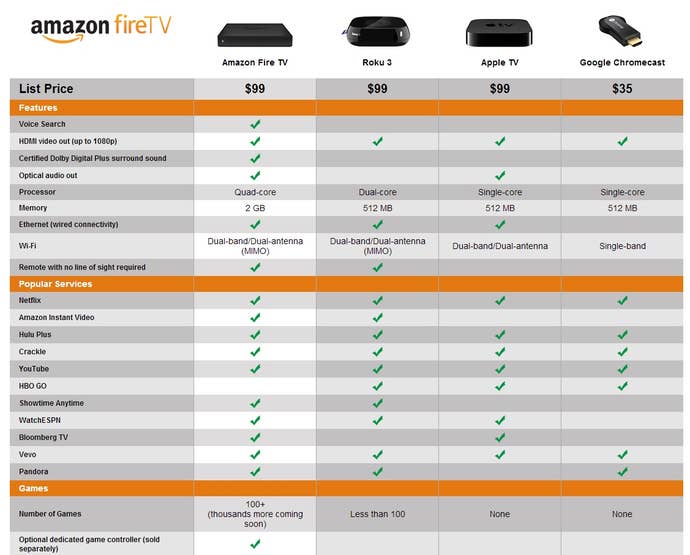What is the Kindle Fire TV? Explaining Amazon's Console
USgamer takes a look at what Amazon revealed this week and why they're releasing a box for your television at all.
This article first appeared on USgamer, a partner publication of VG247. Some content, such as this article, has been migrated to VG247 for posterity after USgamer's closure - but it has not been edited or further vetted by the VG247 team.
On Wednesday, Amazon took the wraps off its worst kept secret, the Kindle Fire TV. The small box isn't larger than 5 inches on any side (4.5" x 4.5" x 0.7" to be exact), making it wider than an Apple TV, but a bit flatter as well. Outside of a number of ports, the box has no discerning features other than the Amazon logo. The Fire TV itself is essentially a high-powered Amazon tablet with no screen.
Just The Basics

It's full specifications put it firmly in line with last year's flagship mobile phones. It's built on the Qualcomm Snapdragon 8064 system-on-a-chip, meaning the Fire TV is powered by a 1.7 Ghz quad-core Qualcomm Krait 300 backed by an Adreno 320 GPU. The system has 2 GB of RAM, 8 GB of internal storage, dual-band WiFi, and Bluetooth 4. On the back of the system, you get an HDMI-out port, optical audio out, ethernet connection, and USB 2.0 port. On the video side it shows 1080p and 720p content in H.263, H.264, MPEG4-SP, and VC1 formats. On the audio side, it has Dolby Digital Plus, 5.1 surround sound, and stereo, with support for AAC, AC-3, E-AC-3, HE-A, PCM, and MP3 formats.
Again, these specs don't compare to this year's Galaxy S5, Galaxy Note 3, iPhone 5S, HTC One M8, or any other flagship phone you can throw at it. But the Kindle Fire TV doesn't have to beat those products, it just has to beat the competition: the Apple TV, Roku 3, and Google Chromecast. Currently, it bests those products technically by a wide margin. The Chromecast is $35 dongle, so it still has a spot in the market, but the Fire TV steps directly up to the Apple TV and Roku 3.
But a box like the Fire TV is useless without content to run. Luckily, the Fire TV is powered by an operating system similar to Amazon's Android-based Kindle Fire tablets. That means most content providers have brought their video and music services over already. So, in addition to Amazon Instant Video, you have access to Netflix, HuluPlus, YouTube, WatchESPN, YouTube, Vevo, Vimeo, Pandora, Crackle, and Revision 3. What's missing? The big misses include HBO Go, Crunchyroll, WWE, and Spotify, all of which are available on Kindle Fire tablets. That means we could see them on the Fire TV in the future, but they're odd holes to have at launch.
And by launch, I mean right now, because you can head to Amazon and purchase a Fire TV today. When buy the Kindle Fire TV for the $99 asking price, you get the Fire TV itself and its remote.

The remote is one of the big selling points of the Fire TV. After looking at the Apple TV, Amazon decided that the most annoying thing in the world was pecking through an onscreen keyboard to find content. When you want to find something on Fire TV, you just hit the Microphone button on the top of the remote and say what you're looking for. That could be a movie, TV show, actor, or genre; say what it is and Amazon's search will do its best to find matching content. Unfortunately, that search functionality doesn't extend to third-party apps like Netflix. As Time noted in a hands-on, if you did a voice search for "House of Cards", the Fire TV will pull up a single season of the show for purchase, instead of the free two seasons on Netflix. It's a problem similar to the one Microsoft has with the Xbox One; third-party services are only integrated to the degree that both companies care and are working together.
Amazon is also heavily pushing a feature called ASAP, which guesses what content you might want to see and pre-loads it. If Amazon's predictive algorithm actually works, the idea is that your Fire TV will immediately start playing a movie or TV show when you take your pick, because it knew you were going to want to see it. That's a big "if" currently.
What About The Games?

This is a gaming site, so what you really want to know about is the games. You can play some titles with the Fire TV remote, but if you're really serious about gaming on the Kindle Fire TV, you'll want to spend another $40 on the Amazon Fire Game Controller. Amazon says the Fire game controller doubles the available list of games, but the list of Remote and Controller games on Amazon is basically the same. The Fire controller uses basic AA batteries and Amazon says the controller will provide up to 55 hours of play on a single set. The controller itself has a layout that matches the Xbox One and Xbox 360 controllers and it connects to the system via Bluetooth. This opens up the possibility of hooking your PlayStation 4 controller to the Fire TV, but that has yet to be confirmed.
Pete did a great overview yesterday on what you can expect from the Kindle Fire TV's launch lineup. Highlights include Minecraft, The Walking Dead Season One, Zen Pinball 2, Double Dragon Trilogy, Sonic the Hedgehog 4, Terraria, Tetris, and Deus Ex: The Fall. If those all sound like Android titles, they are. See the Fire TV is the end of a long line. First there are Android games, then there are Android games on the Amazon Appstore, and finally a few of those will pass onto the Fire TV. That's how the 50,000+ games on the Amazon Appstore end up with 130+ on supporting the Fire TV.
This leaves the Fire TV is a similar spot to the Ouya. Developers had to go out of their way to support the microconsole and when sales didn't stack up, they went elsewhere. Amazon, on the other hand has a lot of money and decent publisher/developer relation through its Appstore and Amazon Digital Games Store.

Even further than that, Amazon is spending a decent amount of money to create original game content for the Fire TV. Amazon Games Studios is the company's primary games development house and has already released its first game, Sev Zero. The title is Amazon's gaming showcase and comes with the Fire game controller for free. It's a third-person shooter/tower defense hybrid that look pretty good for a high-end Android title, but won't be convincing players to leave the Xbox One and PS4 anytime soon. Sev Zero also has a companion app on Kindle Fire tablets for second-screen play. Like I said, it's the showcase.
We still don't know what's coming from Killer Instinct and Strider developer Double Helix Games, a studio Amazon acquired a month ago. We also recently found out about two other hires at Amazon Games Studios via LinkedIn: Portal and Quantum Conundrum creator Kim Swift and Splinter Cell and Far Cry 2 designer Clint Hocking. Both developers are senior game designers at Amazon Games Studios, working on unannounced projects. For now, Amazon looks like its serious about gaming.
Why Amazon Doing This At All?
Why did Amazon make the Fire TV and why are they pushing gaming so hard? For the answer to the first question you just need to look at Amazon's list of bestsellers in electronics. In the Top 10, the non-Amazon devices include the Google Chromecast, the Roku 3500R Streaming Stick, the Roku 3, and Apple TV. When people are buying electronics, they're buying media streaming devices. In fact, I'd argue a number of people don't need things like Blu-Ray or CD players anymore. Tablets, smartphones and services like Netflix have gotten many consumers used to the idea of a box that just streams their content. They're not as worried about things living in the cloud (until the internet connection dies, of course.)

Amazon doesn't just want to be the video or music service on someone else's box. They want to control the experience from end-to-end. That means that not only do they make all the money, but they can ensure that their services look and perform the best (see the problems with Netflix connecting to voice search above). It's the same reason Microsoft is trying to push Xbox One and Windows as a single connected service and why Google has its account hooks in Google Services and Android.
Amazon looked at what people were buying and it decided there was money to be made. And unlike Apple and Roku, Amazon has access to a vast database of information about what's wrong with competitor's products. Every time someone leaves a Roku 3 or Apple TV review, Amazon has that information. When buyers returned their products, they also told Amazon why those products were dissatisfying. It's an amazing trove of what buyers liked and didn't like about those services; all Amazon had to do was leverage its experience in building the Kindle Fire tablets and not make the same mistakes.
For the second question - why are they pushing gaming so hard? - it helps you think about what people do on their tablets and televisions. They watch stuff and play games. On Apple's App Store, 18 percent of all apps are games. The next closest category is educational apps at 10 percent. Games account for 40 percent of all downloads on the App Store and Google Play, according to mobile data analyst site App Annie. The data also showed that games accounted for 80 percent of all Google Play Store revenue and 70 percent of all App Store revenue in Q3 2013. Gaming is where the money is.

And gaming helps Amazon differentiate their $100 black box that streams stuff from Apple and Roku's similar products. It's another bullet point on the website that looks good to prospective customers and beyond that, the company also has a chance to shave off a few possible console buyers as well. The "blue ocean" that made the Wii a resounding success? Those are the kind of consumers Amazon could lock down this time around. And if they do, their platform starts to look even better for developers who are already working on Android-based titles.
Worst-case scenario, Amazon's Kindle Fire TV does about as well as its Kindle Fire tablets. They're not market leaders. TechCrunch reported that the analysts at Gartner estimate around 9 million Kindle tablets were sold in 2013, compared to the 70 million iPads sold in the same time. But every Kindle Fire and Fire TV sold drives consumers directly towards Amazon services. Best case scenario, Amazon ends up owning the media streaming market and makes a mint on game, TV show, and movie sales.
Either way, Amazon is attempting to go big and if it's Kindle Fire efforts are any indication, it's not going home anytime soon.

